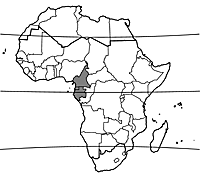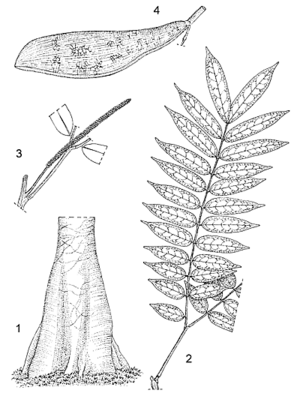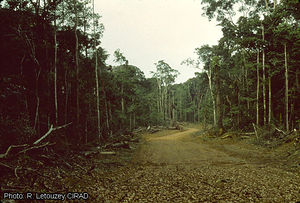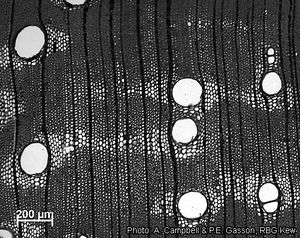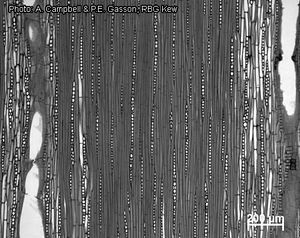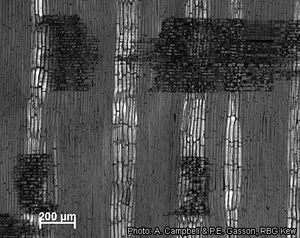Calpocalyx heitzii (PROTA)
Introduction |
| General importance | |
| Geographic coverage Africa | |
| Geographic coverage World | |
| Timber | |
| Ornamental | |
| Fibre | |
| Conservation status | |
Calpocalyx heitzii Pellegr.
- Protologue: Bull. Soc. Bot. France 84: 643 (1937).
- Family: Mimosaceae (Leguminosae - Mimosoideae)
Vernacular names
- Miama (Fr).
Origin and geographic distribution
Calpocalyx heitzii has a restricted area of distribution, occurring in southern Cameroon, Equatorial Guinea and Gabon, particularly in coastal forest.
Uses
The wood is used for indoor as well as outdoor construction. It is also suitable for flooring, mine props, shipbuilding, vehicle bodies, furniture, agricultural implements, interior trim, joinery, railway sleepers, poles and piles, carving, toys and novelties, turnery and pattern making.
Production and international trade
The timber of Calpocalyx heitzii has been exported in small quantities from Cameroon and Gabon to Europe under the trade name ‘miama’. Probably it is still traded in mixed consignments with other medium-heavy timbers of similar colour.
Properties
The heartwood is reddish brown, often with irregular brown streaks, usually distinctly demarcated from the wide pale pinkish grey sapwood. It is sometimes traded as a substitute of African mahogany (from Khaya spp.), which has a similar figure.
The wood is heavy, with a density of about 800 kg/m³ at 15% moisture content, and hard. The grain is often wavy and irregular, texture moderately coarse to fine. The rates of shrinkage are high, 4.7–6.5% radial and 8.5–11.4% tangential from green to oven dry. The timber should be seasoned with great care to avoid distortion, and stock should be quartersawn.
Recorded mechanical properties show a wide range: at 12% moisture content, the modulus of rupture is 125–215 N/mm², modulus of elasticity 9220–17,650 N/mm², compression parallel to grain 54–88 N/mm², and shear 8.8–17.0 N/mm².
The working properties are variable, depending on the amount of irregular grain in the material. The wood saws moderately well, and planing may result in woolly surfaces due to tension wood. Pre-boring is necessary for nailing and screwing. The wood is moderately durable and liable to termite and Lyctus attacks. The heartwood is extremely resistant to preservative treatment, the sapwood moderately resistant.
Description
- Medium-sized to fairly large tree up to 35 m tall; bole straight, cylindrical, up to 90 cm in diameter, with steep buttresses; bark grey to greyish brown, with irregular ridges forming a reticulate pattern, inner bark fibrous, pinkish-brown; branches often hollow.
- Leaves alternate, bipinnately compound with a single pair of pinnae; stipules linear, caducous; petiole up to 13 cm long, shortly hairy, with large gland at apex on upper side; axes of pinnae (17–)30–52 cm long; leaflets in 8–15 pairs per pinna, opposite, oblong-lanceolate to narrowly elliptical, up to 15 cm × 3.5 cm, acuminate, papery, glabrous.
- Inflorescence an axillary pendent spike 6–15 cm long, many-flowered.
- Flowers bisexual, regular, 5-merous, small, sessile, slightly hairy; calyx campanulate, c. 2 mm long, shortly toothed; petals fused at base, c. 4 mm long, whitish yellow to pale brown; stamens 10, free, longer than petals, with glands at apex; ovary superior, slightly stalked, hairy, 1-celled, style long and slender.
- Fruit an obliquely obovoid pod up to 20 cm × 4.5 cm, strongly flattened, long-attenuate at base, obtuse at apex, woody, brown, 2-valved, 6– 8-seeded.
- Seeds angular, flattened.
- Seedling with epigeal germination.
Other botanical information
Calpocalyx comprises 11 species and is restricted to the more humid forest types of West and western Central Africa. It is related to Xylia, which differs in its head-like inflorescences. Western Central Africa counts 9 species, West Africa 2. Most of the Central African species have small distribution areas.
Calpocalyx dinklagei
Calpocalyx dinklagei Harms occurs from Nigeria to Cabinda (Angola), and is locally common in evergreen forest, especially in Cameroon. Its wood resembles that of Calpocalyx heitzii and is used for carpentry, but Calpocalyx dinklagei is usually only a small tree up to 15 m tall with a bole of up to 25 cm in diameter. It differs additionally in its glabrous petioles and wider leaflets. In Cameroon pulverized bark of Calpocalyx dinklagei is applied to wounds and as an anodyne.
Calpocalyx klainei
Calpocalyx dinklagei is sometimes confused with Calpocalyx klainei Pierre ex Harms, also a small tree, but the latter occurs mainly in coastal forest in southern Cameroon, Equatorial Guinea and Gabon, and differs in having shortly hairy petioles and longer fruits. Probably Calpocalyx klainei is also occasionally exploited for its timber. It is rated as vulnerable in the IUCN Red List of threatened species. Several other Calpocalyx species are undoubtedly also felled occasionally in Cameroon, Equatorial Guinea and Gabon for their timber.
Anatomy
Wood-anatomical description (IAWA hardwood codes):
- Growth rings: 2: growth ring boundaries indistinct or absent.
- Vessels: 5: wood diffuse-porous; 13: simple perforation plates; 22: intervessel pits alternate; (23: shape of alternate pits polygonal); 25: intervessel pits small (4–7 μm); (26: intervessel pits medium (7–10 μm)); 29: vestured pits; 30: vessel-ray pits with distinct borders; similar to intervessel pits in size and shape throughout the ray cell; 42: mean tangential diameter of vessel lumina 100–200 μm; (43: mean tangential diameter of vessel lumina ≥ 200 μm); 46: ≤ 5 vessels per square millimetre; 47: 5–20 vessels per square millimetre; 58: gums and other deposits in heartwood vessels.
- Tracheids and fibres: 61: fibres with simple to minutely bordered pits; (65: septate fibres present); 66: non-septate fibres present; 69: fibres thin- to thick-walled.
- Axial parenchyma: 79: axial parenchyma vasicentric; 80: axial parenchyma aliform; 81: axial parenchyma lozenge-aliform; 83: axial parenchyma confluent; (84: axial parenchyma unilateral paratracheal); 91: two cells per parenchyma strand; 92: four (3–4) cells per parenchyma strand.
- Rays: 97: ray width 1–3 cells; 104: all ray cells procumbent; 115: 4–12 rays per mm.
- Mineral inclusions: 136: prismatic crystals present; 142: prismatic crystals in chambered axial parenchyma cells.
Growth and development
The growth of Calpocalyx heitzii is quite fast. In the Sibange arboretum near Libreville, Gabon, a 67-year-old planted plot showed a mean annual growth rate of about 10 m³/ha. The stand was very dense, 567 trees/ha, and the mean annual growth in diameter was only 5.4 mm/tree (9 mm for the biggest trees). The mean volume per tree is 1.4 m³ (5.9 m³ for dominant trees). The fruits of Calpocalyx heitzii dehisce explosively during the dry season, shattering the seeds.
Ecology
Calpocalyx heitzii occurs in primary and old secondary rainforest, most abundantly in littoral forest. In southern Cameroon Calpocalyx heitzii is locally common together with Sacoglottis gabonensis (Baill.) Urb. in lowland evergreen forest and coastal forest up to 200 m altitude and with an annual rainfall of 2200–2800 mm.
Management
Calpocalyx heitzii is characterized as a non-pioneer light demander. Trees of larger sizes usually occur scattered and in low densities. In Gabon the average exploitable timber volume of Calpocalyx heitzii trees with bole diameter over 35 cm has been recorded as less than 4 m³/ha.
Handling after harvest
Freshly felled logs sink in water and cannot be transported by floating down a river.
Genetic resources
Calpocalyx heitzii has a limited area of distribution and could readily be threatened by habitat degradation and felling. It has been classified by IUCN as vulnerable. The best means of protection is by creating forest reserves of large extent within the area of distribution of the species. Some other Calpocalyx species would profit similarly from these measures.
Prospects
Calpocalyx heitzii is an interesting timber tree, of which little is known. Research is needed on its ecological requirements, regeneration and growth rates before its role in natural forests subject to sustainable timber exploitation can be evaluated. Calpocalyx appears in need of a taxonomic revision, but this is hampered by the scanty material of many species present in herbaria.
Major references
- Anonymous, 1978. Miama. Holz Zentralblatt 104(55): 830.
- Bolza, E. & Keating, W.G., 1972. African timbers: the properties, uses and characteristics of 700 species. Division of Building Research, CSIRO, Melbourne, Australia. 710 pp.
- Raponda-Walker, A. & Sillans, R., 1961. Les plantes utiles du Gabon. Paul Lechevalier, Paris, France. 614 pp.
- Villiers, J.-F., 1989. Leguminosae - Mimosoideae. Flore du Gabon. Volume 31. Muséum National d’Histoire Naturelle, Paris, France. 185 pp.
Other references
- de Saint-Aubin, G., 1963. La forêt du Gabon. Publication No 21 du Centre Technique Forestier Tropical, Nogent-sur-Marne, France. 208 pp.
- InsideWood, undated. [Internet] http://insidewood.lib.ncsu.edu/search/. May 2007.
- Normand, D. & Paquis, J., 1976. Manuel d’identification des bois commerciaux. Tome 2. Afrique guinéo-congolaise. Centre Technique Forestier Tropical, Nogent-sur-Marne, France. 335 pp.
- Takahashi, A., 1978. Compilation of data on the mechanical properties of foreign woods (part 3) Africa. Shimane University, Matsue, Japan, 248 pp.
- Tchouto, M.G.P., 2004. Plant diversity in a Central African rain forest. Implications for biodiversity conservation in Cameroon. PhD thesis, Department of Plant Sciences, Biosystematics Group, Wageningen University, Netherlands. 208 pp.
- Villiers, J.-F., 1984. Le genre Calpocalyx (Leguminosae, Mimosoideae) en Afrique. Bulletin du Muséum National d’Histoire Naturelle, 4e série, section B, Adansonia 6(3): 297–311.
- Wilks, C. & Issembé, Y., 2000. Les arbres de la Guinée Equatoriale: Guide pratique d’identification: région continentale. Projet CUREF, Bata, Guinée Equatoriale. 546 pp.
Sources of illustration
- Villiers, J.-F., 1989. Leguminosae - Mimosoideae. Flore du Gabon. Volume 31. Muséum National d’Histoire Naturelle, Paris, France. 185 pp.
- Wilks, C. & Issembé, Y., 2000. Les arbres de la Guinée Equatoriale: Guide pratique d’identification: région continentale. Projet CUREF, Bata, Guinée Equatoriale. 546 pp.
Author(s)
- R.H.M.J. Lemmens, PROTA Network Office Europe, Wageningen University, P.O. Box 341, 6700 AH Wageningen, Netherlands
Correct citation of this article
Lemmens, R.H.M.J., 2006. Calpocalyx heitzii Pellegr. In: Louppe, D., Oteng-Amoako, A.A. & Brink, M. (Editors). PROTA (Plant Resources of Tropical Africa / Ressources végétales de l’Afrique tropicale), Wageningen, Netherlands. Accessed 18 December 2024.
- See the Prota4U database.

